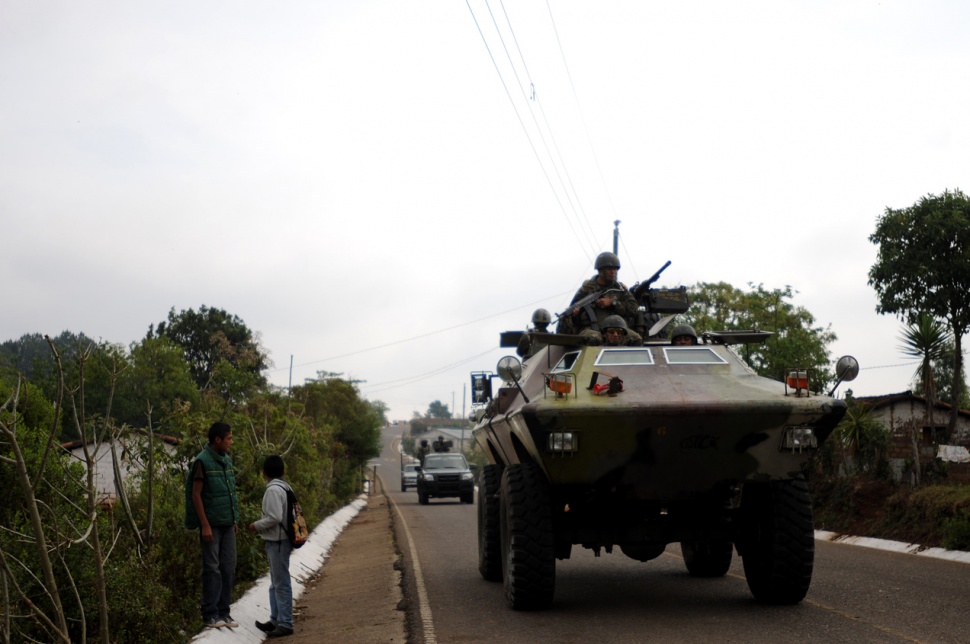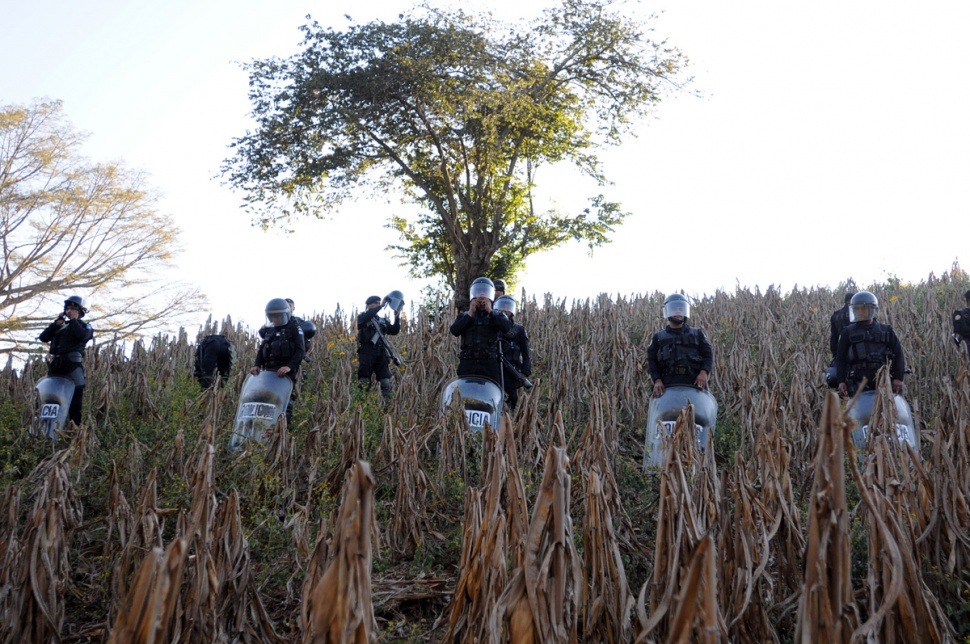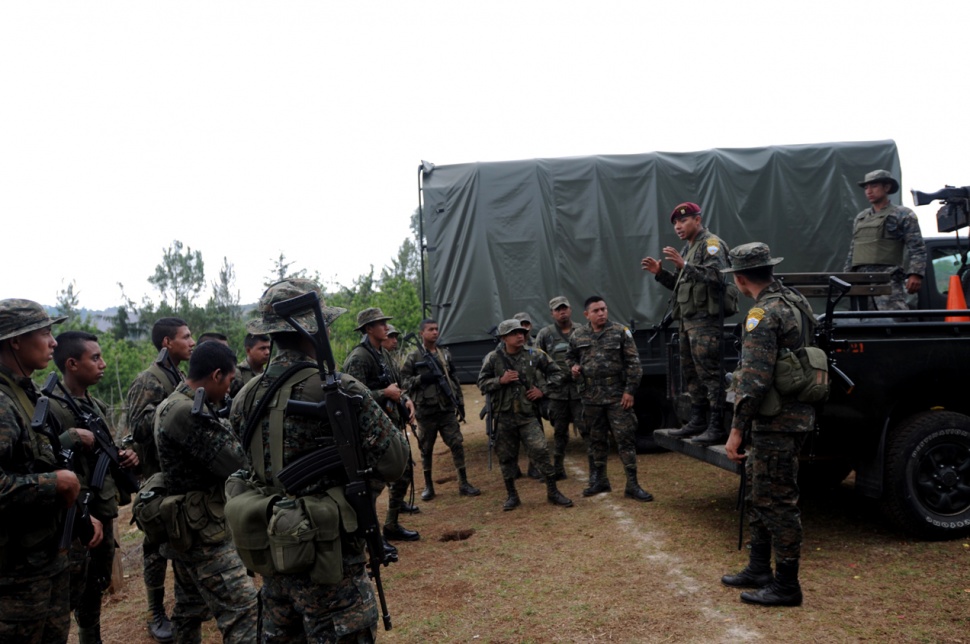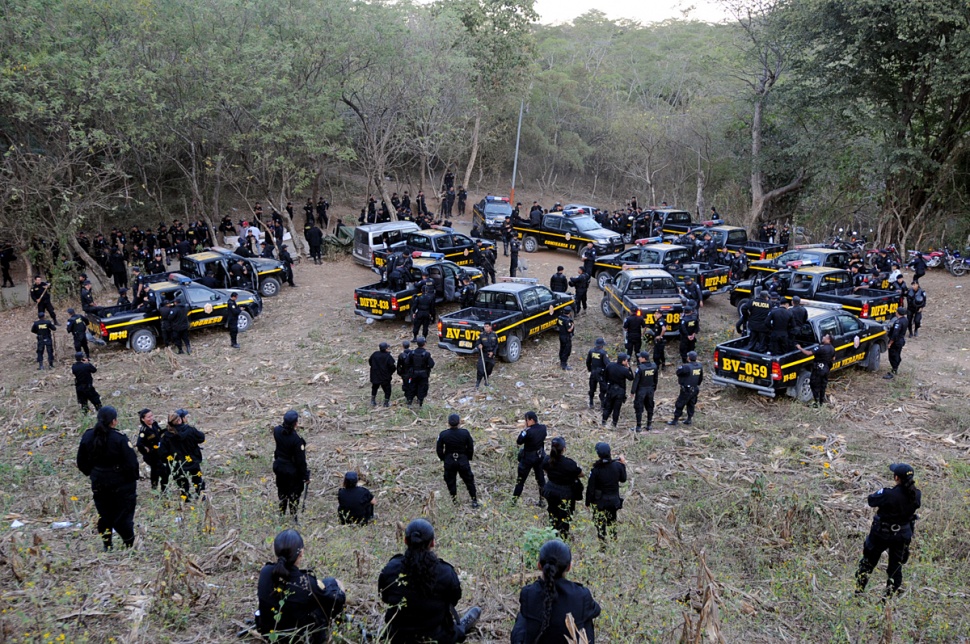The San Rafael Las Flores mine conflict created something more than a State of Siege in response to residents’ opposition to the exploitation of their lands. It was the starting point for the Government’s trial of a new, secretly launched security strategy that terms movements opposing extraction as threats to national security.
 The San Rafael Las Flores mine conflict created something more than a State of Siege in response to residents’ opposition to the exploitation of their lands. It was the starting point for the Government’s trial of a new, secretly launched security strategy that terms movements opposing extraction as threats to national security.
The San Rafael Las Flores mine conflict created something more than a State of Siege in response to residents’ opposition to the exploitation of their lands. It was the starting point for the Government’s trial of a new, secretly launched security strategy that terms movements opposing extraction as threats to national security.
Source: Plaza Pública
San Rafael Las Flores has become a strange place where everyone is wary of each other and distrustful. Since May 2013, after the surrounding municipality of Santa Rosa declared a State of Siege, that’s how things have been. In the streets, the parks, and the small corner shops, people cautiously observe everything that passes in front of them. The alert is spontaneous. Outsiders do not pass through unnoticed.
Do you work for the mines?
Are you from Canada?
What do you want?
These are the questions that arise out of their unease. It happens on the bus, in the restaurant, and, sometimes, on the street. “You have to be careful when talking about mining,” a shopkeeper advises with a smile. He goes on to explain that every other person in San Rafael Las Flores reacts either well or badly, for or against the El Escobal mining project, which a few months ago started to extract silver from the subsoil of San Rafael Las Flores. “The population is divided,” he says. Nevertheless, I ask him, not necessarily having anything to do with the mining company, if he didn’t know the location of a state office, a Government office that had, indeed, a mining name: the “Inter-Agency Mining Affairs Group,” and if by chance he knew anything about it.
From across the showcase, the shopkeeper scratches his head and says: “That name doesn’t ring a bell.”
The same thing happens with a transit officer, a pharmacy employee, and a private security officer. The “Inter-Agency Mining Affairs Group” does not ring a bell with any of them. “Maybe you’re looking for that Government office with the banners,” says a senior citizen in front of the city hall. She then maps out a long route through many paths and streets to get there. “But that’s not the name of that office. I don’t remember what it is right now, but that’s not it,” she clarifies.
***
Since March 26, 2013 the government of Otto Pérez Molina has given the San Rafael Las Flores social conflict special treatment. The National Security Council (CNS) concluded that the social problems —protests, altercations, provocations, blockades— surrounding the extractive projects should be dealt with at another level, as a problem of National Security, that is to say, against the security of the State.
To confront the problem, the “Inter-Agency Mining Affairs Group,” an agency working under the supervision of Coronel Ricardo Bustamante, head of the Technical Secretariat of the National Security Council (STCNS), was formed.
Assistant Ministers of Governance Edi Juárez, Sergio Ruano of Environment and Natural Resources, Mining Director at the Ministry of Energy and Mines Fernando Castellanos, and Miguel Ángel Balcárcel, in charge of the National Dialogue System, made up the first group to listen to the findings on the conflicts made by the State Strategic Intelligence Secretariat (SIE), headed by José María Argueta, after the violent incidents that took place in San Rafael Las Flores in September 2012. Houses were burned during these incidents, as well as equipment and vehicles belonging to the San Rafael mining company, in addition to public and private establishments. More than 50 were injured; four people died, among them an officer of the National Civil Police (PNC).
The “Inter-Agency Mining Affairs Group” was created in March 2013 under the auspices of the National Security Policy, two months before the State of Siege was declared there, and one month before the approval of the Escobal project’s operating licence.
The Presidency drew up a Governmental Accord bill to give legal life to the agency. The National Attorney General’s office received the request and gave it its “seal of approval.” Nevertheless, the agreement to create the “Inter-Agency Mining Affairs Group” was never published.
The bill for a Governmental Accord invests this agency with, among other powers, the ability to “draw up recommendations, policies, strategies and projects that are in nature political, social, economic or related to security for the National Security Council for comprehensive attention to security problems generated by non-renewable natural resource exploration and operations.”
Minister of Governance Mauricio López Bonilla, in statements made to Plaza Pública, recognized that this group has been in operation for almost a year in San Rafael Las Flores, and that “its function is to identify what has failed” in terms of security and “social impact” in the places where mining projects have been launched.
“We believe that the State, as such, when it seeks foreign capital, must be supported from start to finish. This means that when locations are identified as potentially good for resource extraction, one must go to the place, evaluate it, and just as there must be an environmental impact study, so must there be a requirement for social impact studies,” explained the Minister.
This implies, he added, that “in order to have an inter-agency mining affairs group, all institutions that have something to do with the affair must be involved.”
Having an office located in San Rafael Las Flores was important for the group’s operations. What is curious is that no one in San Rafael Las Flores knows where it is. At least not by its real name.
***
The first indication of the existence of this office can be found on the way out of San Rafael Las Flores: a signboard announcing the location of a governmental office. One must follow the directions —some arrows— first to the right, then again in the same direction at another crossing, then straight ahead up to the edge of town, arriving at an unpaved road leading to some pastures in the middle of nowhere.
There, far from everything, the Government office looks more like a fortress. It’s surrounded by metal chain-link and barbed wire, which one must circle completely in order to find the entrance, only to be found embedded into a strategic point atop a small hill: any visitor is viewable in advance. Most of the town can be seen from this office.
The façade of the building reads: “Inter-Agency Office for Comprehensive Development”.
Is this the headquarters of the “Inter-Agency Mining Affairs Group,” run by the Technical Secretariat of the National Security Council?
It does not appear to be at first sight.
***
 Weeks earlier, Eduardo Spiegeler, from the Assessment and Planning Commission (CAP) of the National Security Council, confirmed, as did López Bonilla, that the national security mining affairs group was operating in San Rafael Las Flores.
Weeks earlier, Eduardo Spiegeler, from the Assessment and Planning Commission (CAP) of the National Security Council, confirmed, as did López Bonilla, that the national security mining affairs group was operating in San Rafael Las Flores.
“At a certain point, it was felt that the mining was creating a kind of generalized conflict. And it’s not a problem in just one place, as in San Rafael Las Flores, Santa Rosa, or the Guatemalan Nickel Company in Izabal, or El Tambor in San José del Golfo. The council (CNS) took note of this and elevated it to a problem that could engender a threat to the nation. Something that, in and of itself, could affect the governance of the country,” explained the CNS evaluator.
But how does a group of this type operate? How is mining managed through a National Security Policy?
Spiegeler says that they have detected various factors explaining communities’ negativity that natural resources will be exploited and taken advantage of. “Lack of information,” he points out. “The problem with that is that there hasn’t been good, strategic communication that really generates trust about what is going to be done.”
— Should the companies be the ones to give out the information?
—This is an activity that belongs to the State. Giving communities reliable and accurate information about what’s happening.
López Bonilla explains by clarifying: “The idea is to change what had been previously developing. For example, the State convenes and grants a licence for recognizance, then exploration and then operating, with the result being we have a problem with conflicts in the area. So, how to manage the conflict, in logical order: Go back to the origin. What to do is speak about the project, what is consists of, impact, benefits. And the most important feature of this is a National Security Policy focused on mining affairs.”
***
The “trust” that, according to Spiegeler, is to be generated in the public is the least of what is perceived at the governmental office “for Comprehensive Development.” which, in reality, is the headquarters of the “Inter-Agency Mining Affairs Group,” located on the outskirts of San Rafael Las Flores.
There are various public officials gathered inside.
—Are you the STCNS Inter-Agency Mining Affairs Group? —the group observed inside the office are asked.
—No. If you read outside, this is an office for Comprehensive Development —says Coronel Mario René Gálvez, delegate to the Governance Ministry.
—We don’t have anything to do with the mine —immediately exclaims Giovanni Martínez, National Dialogue System (SND) representative.
Anyhow, it appears to be a meeting with technicians and laborers. Technicians like engineers Fredy Navarro, from the Ministry for the Environment and Natural Resources; Julio Chacón, of the Ministry for Energy and Mieas; and Luis Martínez of the National Council for Protected Areas. And laborers like Mario Pozuelos —who takes photos of the reporter from Plaza Pública — from the Technical Secretariat of the National Security Council and Coronel Gálvez.
—Sorry, but the Governance Ministry says something else.
— ….
—This is a State office covering public requests. It gives advice, provides information to whoever asks, and gives technical and scientific answers about the mine. We supervise the mine —explains Martínez of the SND.
—What are your activities?
—For example, right now we are conducting a water study. But also, each agency compiles data, brings it here, and we analyze it all. We send everything to the STCNS —comes the answer from Martínez. This time, he points to the roadmap, and indicates that it does indeed say the “Inter-Agency Mining Affairs Group,” but claims that this is an error, and that at a certain point the STCNS decided to call it that. The contradiction rests in that the official documents say one name, and the building we are in says another. Everything is very strange. Even absurd.
—Does the group work in secret?
—…
—No, not at all—says Gálvez.
The whole group seems nervous, at times disturbed, other times surprised, but mostly uneasy. They say, surely, they have a Governmental Accord to operate, but they can’t, or are not able to, remember the number or date of publication in the official journal. In reality, they intended to get the agreement, but in the end, nothing was ever published. The STCNS insists that the National Security System Marco Law regulation (Decree 18-2008 and Accord 166-2011) empowers them to create an inter-agency group at their whim, no need to explain their operations or budget.
***
 “There are two forms of public policy: de facto and de jure,” explains Claudia Samayoa, director of the Union for the Protection of Human Rights Defenders in Guatemala (Udefegua). “In the case of the Inter-Agency Mining Affairs Group, under the National Security Policy, we are looking at a de facto public policy. The fact is that instead of being a mining policy, it is more a social control policy. Instead of reforming the Mining Law, which is necessary, the Government reacts and comes out with a security and national threat issue. This shows how the State wants to organize itself to minimize protest, which is also a constitutional right.”
“There are two forms of public policy: de facto and de jure,” explains Claudia Samayoa, director of the Union for the Protection of Human Rights Defenders in Guatemala (Udefegua). “In the case of the Inter-Agency Mining Affairs Group, under the National Security Policy, we are looking at a de facto public policy. The fact is that instead of being a mining policy, it is more a social control policy. Instead of reforming the Mining Law, which is necessary, the Government reacts and comes out with a security and national threat issue. This shows how the State wants to organize itself to minimize protest, which is also a constitutional right.”
José Cruz, from the environmental collective Madre Selva, goes even further. “This plan is counter-insurgent,” he says. “They are applying it during a democratic period. This type of inter-agency coordination was part of the Army’s strategies during the civil armed conflict. What’s worrisome, however, is how they have been operating in secret.”
Since 1999, after the Peace Accords were signed in Guatemala, the construction of democratic security began to be planned. At the center of the public security policy would be human development. Remedies were sought to some of the legacies of the past, such as the National Security Doctrine’s counter-insurgency. In 2008, the National Security System Marco Law was approved. Its intent was that different agencies would be coordinated around a central axis of power —the CNS — and it dealt with the issue of interior and exterior security under civil authority. It was about abandoning the old ways, the tradition of security in the hands of the military, and moving to a different National Security Policy. Héctor Rosada-Granados, of the Board of Directors of the Center for Strategic Studies and Security in Central America (CEESC), says that throughout this process, the subject of social opposition to mining as a threat to national security was never brought up, but he cautions that each government may identify threats depending on its situation.
“It’s probable that another Government would have interpreted it another way and proceeded to integrate the inter-agency group with other offices, such as incorporating it into the office of the Human Rights Prosecutor, and giving it another focus on conflicts that take place, thereby underscoring compliance with the public’s right to protest, and not seeing that as a threat to national security,” Rosada points out.
—How to explain, then, why the social conflicts stemming from opposition to mining projects are being managed from the perspective of a national security threat?
—A democratic government or one that respects the rule of law would never consider a social protest to be a threat against the State; it would never classify it as destabilizing and dangerous to the security of the nation. On the contrary, an authoritarian government with a military court and a profound history placing it at the genesis of the counter-insurgency policy applied during the civil war, will react and prioritize the same way it did before.
***
In San Rafael Las Flores, the National Security Policy’s implementation has not gone unnoticed. Neighbours notice changes, despite not having been notified that the CNS elevated the social conflict about the mine to a new level. It hardly generates trust to ask someone to explain how life has been in this town since the State of Siege. It has become complicated.
—We feel watched —says a teacher who asks not to be named.
—Cars with armed people pass by all the time —points out a gentleman, gesturing gruffly with his boots and hat.
—It’s affecting the prices of our produce. There’s no way to negotiate. They say our beans, our tomatoes, everything is contaminated with cyanide and we can’t come to a fair price —says a small farmer in the village El Volcancito.
—Everyone is afraid here since the State of Siege, afraid. Nobody talks like before about the mining problem. Or about anything really. The resistance has been annihilated. Silence and distrust fills the town—declares Rudy Pivaral from the Committee in Defence of Life and Peace, one of the few to dare give his name in speaking about the issue.
Few would dare to publically denounce the “Inter-Agency Comprehensive Development Office” of really being, according to Pivaral, “a military intelligence office.”
“It’s just like in the 1970s. It’s pitiful. We’re living in a state of permanent alert. We’ve always thought this office seemed suspicious. They get the names of the leaders, manage community information. We’ve known it even though they say the opposite,” the community leader affirms.
***
 Up until the violence escalated in San Rafael Las Flores, the State confronted social conflict about the mining projects through the National Dialogue System (SDN). Under the direction of Miguel Ángel Balcárcel, the SDN has various critics. Many agree that the reason for the dialogue does not really exist. “They organize, they create a process, a State euphemism, so that the communities accept the companies’ conditions,” emphasizes Samayoa. Even President Pérez Molina has admitted that there were mistakes in the management mechanisms in this instance.
Up until the violence escalated in San Rafael Las Flores, the State confronted social conflict about the mining projects through the National Dialogue System (SDN). Under the direction of Miguel Ángel Balcárcel, the SDN has various critics. Many agree that the reason for the dialogue does not really exist. “They organize, they create a process, a State euphemism, so that the communities accept the companies’ conditions,” emphasizes Samayoa. Even President Pérez Molina has admitted that there were mistakes in the management mechanisms in this instance.
Mediate, inform, create processes to manage conflicts, prevent, most of these functions have been handed over to the Inter-Agency Mining Affairs Group. Miguel Ángel Balcárcel considers, nevertheless, that the SDN continues to work, not in parallel but as a complement.
“The Inter-Agency Group was created because the situation in San Rafael had reached a complicated point. It was necessary to take measures in terms of security, not to attempt to eliminate dialogue, but because the focus changed the course of democracy and governability,” says Balcárcel.
Within this context, according to Cruz de Madre Selva, the SND has increased its operations. “They are mapping leaders and studying scenarios. The dialogue serves as a façade to get close, obtain names, and make captures,” she points out.
Social conflicts surrounding an extractive project are not exclusive to San Rafael Las Flores. It’s not only happening there. There are various confrontations taking place throughout the country. And each one is distinct, with its own complexities, and divergent contexts. In Izabal, in San Marcos. In San Juan Sacatepéquez. Or between San Pedro Ayampuc and San José del Golfo, municipalities in Guatemala, where resistance to the El Tambor mining project was recently subdued.
Yolanda Oquelí, a leader of La Puya, does not doubt that the May 23 eviction this year had been planned at a table at a high-level office like the National Security Council. She suspects that a branch of the Inter-Agency Mining Affairs Group wants to open in San José del Golfo, in secret.
There is no reason for it, points out Oquelí. “We are not a threat.”
Indeed, Spiegeler says that the “Inter-Agency Mining Affairs Group” is a kind of pilot for all of Guatemala: “Put it this way: it’s a pilot plan, a backup so they can lay out community demands. Right now, it’s based in San Rafael Las Flores. They are not looking at any other type of conflict. It was formed just for this. Other conflicts are not managed by the Group for Mining Affairs. National conflict is managed at the Ministry level. And when they ask to replicate this model at that level, from the National Security Policy, in La Puya for example, the STCNS imitates this type of procedure.”
Outside the governmental office in San Rafael Las Flores on the day of the visit, three men were waiting who said they are in charge of establishing an office of this type in San Juan Sacatepéquez, because of the social conflict about the San Gabriel project involving the Cementos Progreso company.
In regards to possibly enlarging the Inter-Agency Mining Affairs Group to cover other places, López Bonilla says that first “the conflicts stemming from what has already been granted must be dealt with” in order to guarantee that the “new model” ensures the viability and certainty of projects which the Government deems “to be strategic.”
It is a new model for development based on the exploitation of natural resources, a model, according to the Governance Ministry, whose objective is to convert Guatemala into a destination for foreign capital investment.
For Héctor Rosada, the model for democratic security coincides with the existence of a State that is able to generate development opportunities for all of its people, and in its capacity to contain the risks, threats and vulnerabilities that may arise. That is to say, “situate itself above those involved in the conflict, and apply the law in moderation, seeking to re-establish the balance that had been lost. The meaning given to the law depends upon the Government’s intentionality in applying it. From there, it will depend upon how the facts are read and what strategies are applied to manage the conflicts.”
—Why not opt to sustain the Governmental Accord that grants judicial backup to the Inter-Agency Group for Mining Affairs?
—Spiegeler was asked.
—Wasn’t it better this way? —answered Eduardo Spiegeler a few days before— I believe that if the Governmental Accord had been published at that time, there would have been a massive demand for this type of offices. Not just for San Rafael, but nationally. We didn’t have the ability to react in that situation. We know that we have the capability today. San Rafael was a trail, a test.
“I don’t know what might have happened there,” said López Bonilla doubtfully about this type of group’s lack of legal backup. “What a Governmental Accord does is institutionalize policies, especially where the Executive branch has a large role. It could have been something administrative. But I can tell you that this Governmental Accord is going to be made concrete, because what we are doing is working within the framework of Law for National Security System to create the conditions for new and better governability in the country,” assures the Minister.
***
Sometimes, leaving San Rafael Las Flores is complicated. You’ve asked questions. The people are distrustful. They have been watching you. They’ve positioned you as someone from outside the municipality. Many, for sure, are uncomfortable with the mining issue. And sometimes scared. As a way of saying goodbye on the bus, a girl —fair, nails painted pink, slim— gets close and says: “You (journalists?) always make mining out to be bad. But you don’t understand. I could never have made before what I make now in this place. I have a good salary. This town was forgotten. Today there is progress. There are hotels and restaurants. We’re doing well. We’re making money.”
She says she’s studying law, and that she can pay for it now. Then she listens calmly, never dropping her defiant stare, to the story of the search for the governmental office on the outskirts of San Rafael Las Flores. To calm her a little, I tell her with mining, nothing, look —I show her— the Governmental Accord bill, National Security Policy, the secrets, the façade.
“Damn them,” she exclaims. “They always do it wrong. Always wrong.”
